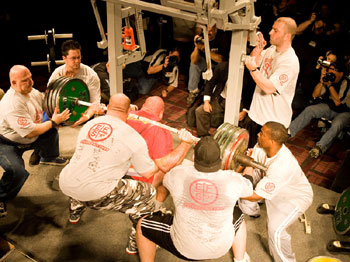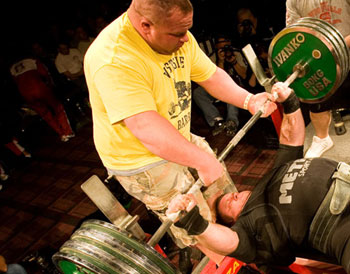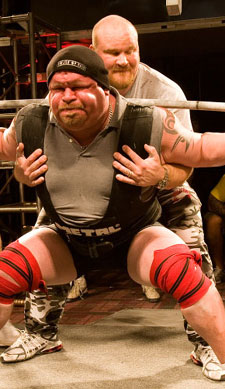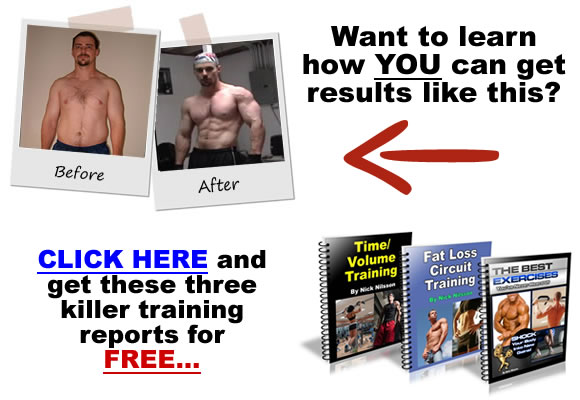|
Be The Best Spotter in The Gym
 Spotting is an important aspect of weightlifting safety, yet it's not something that is ever taught to gymgoers. Having a spotter gives you security and a little extra help to push yourself harder.
Spotting is an important aspect of weightlifting safety, yet it's not something that is ever taught to gymgoers. Having a spotter gives you security and a little extra help to push yourself harder.
Here are some guidelines and rules-of-thumb, both for spotters and for lifters, that will make you a much better (and much safer) spotter.
1. Ask how the person you are spotting wants to be spotted. Some people, when doing dumbell exercises such as the bench press, prefer to be spotted at the elbows by pushing up from underneath with their elbows in your palms, while others prefer the wrists (pulling up on them). Neither way is necessarily right or wrong, it is a matter of preference.
2. Determine the rep range the person is going to be working in. If you start spotting at five reps and they're doing ten, you've just ruined a set. If, on the other hand, you had to start spotting at five and they said ten, they may be expecting another five forced reps out of you.
3. Never take the weight away from the person (unless they really need it taken away for safety reasons). This is especially true on barbell exercises when you're spotting on the bar. Do not pull or push so hard on the bar (unless they ask) that it takes the tension off the muscles. Good spotting means you just add enough force to keep the bar moving. When spotting exercises such as curls, spot by placing your hands under the lifters hands and pushing up on their hands rather than lifting on the bar itself. This will ensure you don't take the weight away as you spot.
4.Find out if the person is going to do any set extension techniques, e.g. negatives, drop sets, forced reps, etc. You should know exactly what's going on so you can be prepared for it. You don't want to mistake an intensity technique for muscular failure that requires a spot.
5. Don't scream encouragement at the person without first making sure they want that kind of thing. It can be very distracting and not everyone likes it or needs it.
6. When spotting on bench press, be sure to wipe the sweat off your face beforehand so you don't drip on the person during their set (not a nice thing to experience). Also, don't lean over them excessively. This can be distracting.
7. As well on bench, ask if the person wants help lifting the bar off the rack. Also, do not spot with one arm in a sort of one arm deadlift. This is a poor balance point and the pull is often uneven. This unbalancing can cause failure for the person lifting the weight.
 8. Spot around the waist on squats, not on the bar. Lower yourself as they go down and follow them up. Help them rack the bar if they need help but never push them forward if they're not ready to move.
8. Spot around the waist on squats, not on the bar. Lower yourself as they go down and follow them up. Help them rack the bar if they need help but never push them forward if they're not ready to move.
9. When it is possible for you to spot yourself (e.g. 1 arm exercises, standing on a chair for chins, etc.), do it. You know better then anyone how much help you need. On the other hand, if you have a tendency to go easy on yourself and bail out too soon, get a spotter to force you to work.
10. When spotting on dumbell bench press, do not push inward on the elbows or the dumbells may cave in on their chest. Always push up.
11. There are exercises where you shouldn't spot people, e.g. deadlifts, hyperextensions, crunches, power cleans, etc. If someone asks you to spot them on these, politely decline.
12. Sometimes a person may ask you to hand them a dumbell on exercises like dumbell bench, incline presses, shoulder presses, etc. Pick up the dumbell with your hands on the weight plate, not the handle itself. If you pick the weight up by the handle and try to hand it over that way, you and the lifter will have to try and somehow trade hand positions on the handle before they can lift the weight. This is not safe at all even with light weights but especially with maximal weights. An easy way to lift a heavy dumbell up to your shoulder level so you can hand it over is to pick it up first on the outside of the plates with both hands, then deadlift it to a standing position. Now rest the handle of the dumbell on one of your thighs, kick that leg up, throwing the dumbell up to your upper chest. Set it in their hand from there.
13. On some machines such as the pec deck, for example, it is better to spot by lifting the weight stack itself (watch your hands!). This keeps the tension on the muscle far better during the set. Do not place your hands underneath the plates, however. Just grasp the weight plates on the sides and push up to help. This should only be used for light help, not for full-power forced reps.
14. When using two spotters (e.g. for heavy squats or bench), have one at each end of the bar and ensure they pull up simultaneously. An unbalanced load can mean trouble.
15. If you need a spotter on every set of every exercise you do, you are either working too hard or not hard enough. On one hand, doing too many forced reps will rapidly overtrain you, while on the other hand, letting the spotter do much of the work will prevent progress. Try doing a few sets completely on your own (without any spot at all) to see if you are actually doing all the work. It is not good to be overly dependent on spotting outside of what is necessary for safety reasons. If you can't lift the weight by yourself then you shouldn't be doing it at all. The exception to this is negative training and legitimate forced reps.
16. A good spotting technique is the finger spot. If, for example, you are spotting someone on bench press and the bar is slowing down and almost stopped, use only your two index fingers underneath the bar. This is often more of a mental boost for the lifter than an actual spot. At this point, apply just enough pressure to keep the bar moving. If the fingers aren't enough, grip the bar and continue to help just enough to keep it moving. This will make the lifter do much more of the work themselves. They'll either love your spotting or never ask you to do it again!
 17. When spotting, ease up as the lifter moves past the sticking point and into the stronger range of motion. For example, when spotting on bench, help just through the sticking point, then, as the leverage improves, reduce your help as the bar comes up, letting up completely as the bar comes to the top. To increase the value of the set, you may even want to lean on the bar a little as it comes to the top (check with your lifter first before doing this). This will help increase lockout power.
17. When spotting, ease up as the lifter moves past the sticking point and into the stronger range of motion. For example, when spotting on bench, help just through the sticking point, then, as the leverage improves, reduce your help as the bar comes up, letting up completely as the bar comes to the top. To increase the value of the set, you may even want to lean on the bar a little as it comes to the top (check with your lifter first before doing this). This will help increase lockout power.
18. If you see someone struggling with a weight, don't run over and yank the weight up. This can be dangerous for the trainer and tends to make people angry. Make your presence known but don't help until the trainer signals you for help. If you see someone being crushed under a bench press, however, that is when you should run over and help without asking.
19. When spotting, focus all your attention on the set, no matter who walks by or who talks to you. You are responsible for ensuring the safety of the lifter.
20. Don't spot until it is absolutely necessary. The most productive part of a set is near the end where the lifter is struggling with the weight. By helping too soon, you will reduce the effectiveness of the set.
21. Don't base the amount weight you use totally on the strength of your spotter. You should be using your own strength for your sets. This is not to say you shouldn't have a strong spotter, though. Another exception is dumbell spotting where the spotter must hand the weight to you. Obviously, you'll need to find someone strong enough to be able to do that effectively.
22. Machines that have foot levers to help you get the weight into position can be used to spot yourself. If you can get the coordination right, you can use the lever to catapult the weight out of the bottom position.
23. Spotting is okay for beginners learning form and limitations but only for safety, not for excess reps. This is one of the major mistakes beginning trainers make when starting a training program. Overuse of forced reps, i.e. unnecessary spotting, can lead to burnout and excessive soreness. In these cases, spotting should only be used to keep the lifter safe, not to push them harder.
As you can see, there's more to spotting than simply pulling on a bar or pushing on the elbows. A good spot should maximize the results and safety of the lifter. Remember these guidelines the next time someone asks you for a spot or the next you ask someone else for a spot!

More Articles by Author Nick Nilsson
Return To Weight Lifting Articles Archive
|